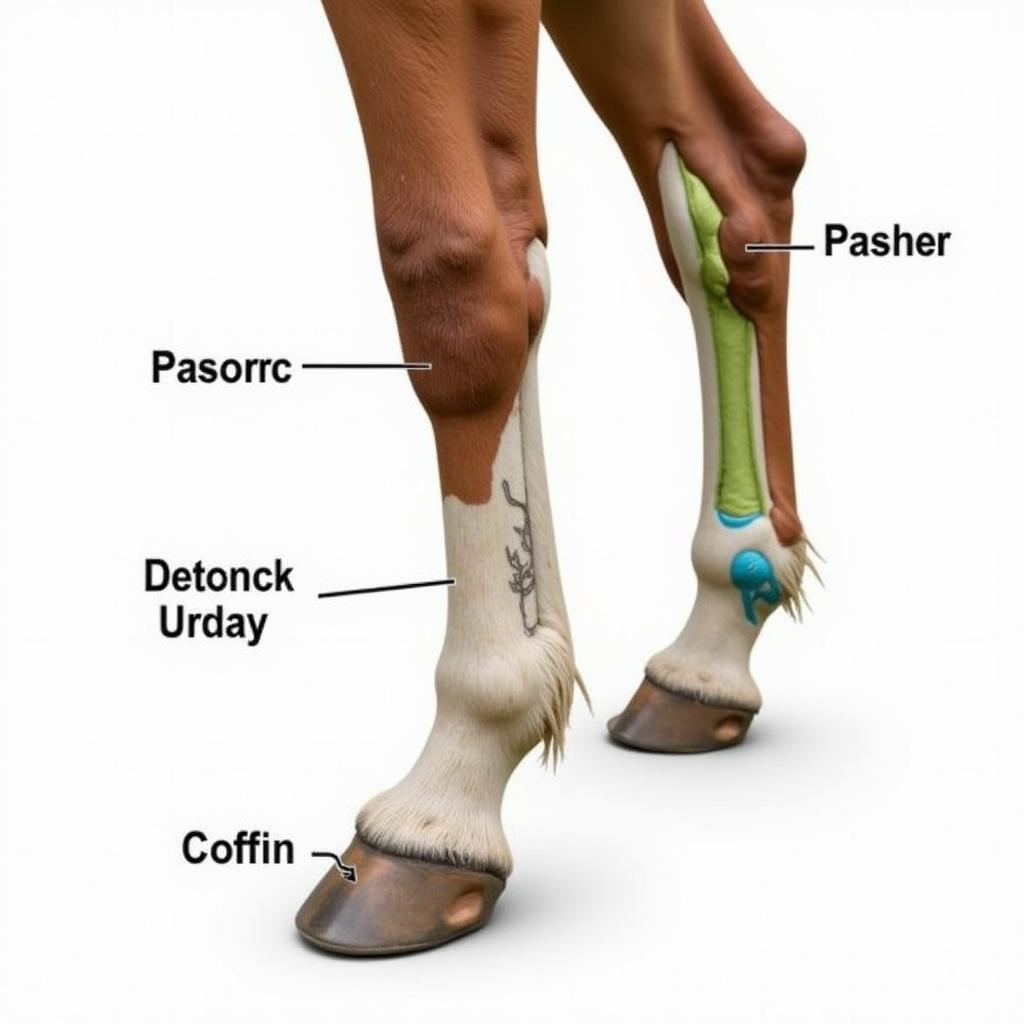Understanding Horse Joints Anatomy is crucial for every horse owner. A deep dive into the intricacies of their musculoskeletal system helps ensure their well-being and performance. This knowledge aids in recognizing potential issues, implementing preventive measures, and seeking appropriate veterinary care when necessary. We’ll explore the structure and function of these complex joints, highlighting common problems and offering insights into maintaining their health.
The Complex World of Horse Joints Anatomy
Equine joints are marvels of biological engineering, allowing for the incredible athleticism and grace we admire in these animals. Each joint plays a vital role in movement, from the subtle nuances of dressage to the powerful strides of a racehorse.
Major Joint Groups in Horses
Horse joints anatomy can be categorized into several major groups, each with its unique characteristics and functions:
- Synovial Joints: These are the most common type in horses, characterized by a joint capsule filled with synovial fluid, which acts as a lubricant. Examples include the knee, fetlock, and coffin joint.
- Fibrous Joints: These joints are connected by fibrous tissue and offer limited movement. The skull bones are an example.
- Cartilaginous Joints: These joints are connected by cartilage and allow for a small degree of movement. They are found between the vertebrae in the spine.
Key Components of a Horse Joint
Each synovial joint, critical for a horse’s mobility, is composed of several key elements:
- Cartilage: This smooth, resilient tissue covers the ends of the bones within the joint, absorbing shock and allowing for frictionless movement.
- Synovial Membrane: This membrane lines the joint capsule and produces synovial fluid, which nourishes and lubricates the cartilage.
- Joint Capsule: A tough, fibrous sac that encloses the joint, providing stability and support.
- Ligaments: These strong bands of connective tissue connect bones to bones, stabilizing the joint and restricting excessive movement.
- Tendons: These connect muscles to bones, enabling movement of the joint.
 Horse Leg Joint Anatomy
Horse Leg Joint Anatomy
Understanding these components is essential for grasping how horse joints function and what can go wrong when they are injured or diseased.
Common Joint Problems in Horses
Just like human athletes, horses are susceptible to various joint issues. Some common problems affecting horse joints anatomy include:
- Osteoarthritis: A degenerative joint disease characterized by cartilage breakdown, leading to pain, stiffness, and inflammation.
- Arthritis: General inflammation of a joint, often caused by infection, trauma, or autoimmune diseases.
- Ligament and Tendon Injuries: Strains, sprains, and tears can occur due to overexertion or trauma.
- Synovitis: Inflammation of the synovial membrane, causing excess fluid buildup and joint swelling.
“Maintaining healthy joints is paramount for a horse’s performance and overall well-being,” says Dr. Emily Carter, DVM, specializing in equine sports medicine. “Regular exercise, proper nutrition, and attentive monitoring are crucial for early detection and prevention of joint problems.”
Maintaining Healthy Horse Joints
Proactive management is key to preserving healthy horse joints throughout their lives. Here are some essential strategies:
- Balanced Diet: Provide a diet rich in essential nutrients, including vitamins, minerals, and antioxidants, to support joint health.
- Regular Exercise: Controlled exercise helps maintain joint flexibility and strength. Avoid overexertion, especially on hard surfaces.
- Weight Management: Excess weight puts added stress on joints, increasing the risk of injury and disease.
- Supplements: Consult with a veterinarian about joint supplements, such as glucosamine and chondroitin, which may help support cartilage health.
“Early intervention is key in managing joint issues,” adds Dr. Carter. “If you notice any signs of lameness, stiffness, or swelling, consult a veterinarian promptly for a thorough evaluation and appropriate treatment plan.” For information on horse hocks, check out horses hocks. Understanding the different parts of a horse bit can be found on our page about horse bit parts. If you’re interested in leaping horses, visit our dedicated page leaping horses. You can also explore the complete atlas of horse for detailed anatomical information. For those curious about the cost of Arthramid for horses, please refer to our arthramid for horses cost page.
Conclusion
Understanding horse joints anatomy empowers owners to provide the best possible care for their equine companions. By recognizing the complexity of these vital structures, implementing preventive strategies, and seeking timely veterinary care, we can contribute significantly to their long-term health, soundness, and performance. Maintaining healthy horse joints is a continuous effort that pays off in the long run.
FAQ
- What is the most common joint problem in horses? Osteoarthritis is a prevalent issue.
- What are the signs of joint pain in horses? Lameness, stiffness, swelling, and reluctance to move are common indicators.
- How can I prevent joint problems in my horse? A balanced diet, regular exercise, and weight management are crucial.
- What are joint supplements for horses? Glucosamine and chondroitin are commonly used to support cartilage health.
- When should I consult a veterinarian about my horse’s joints? Consult a veterinarian promptly if you notice any signs of lameness or joint discomfort.
- What are some other resources for information on horse anatomy? Consult veterinary textbooks, online resources, and university extension programs.
- How can I learn more about specific joint conditions? Research online and speak with your veterinarian for detailed information.
If you need further assistance, please contact us at Phone Number: 0772127271, Email: [email protected] or visit us at QGM2+WX2, Vị Trung, Vị Thuỷ, Hậu Giang, Việt Nam. Our customer support team is available 24/7.